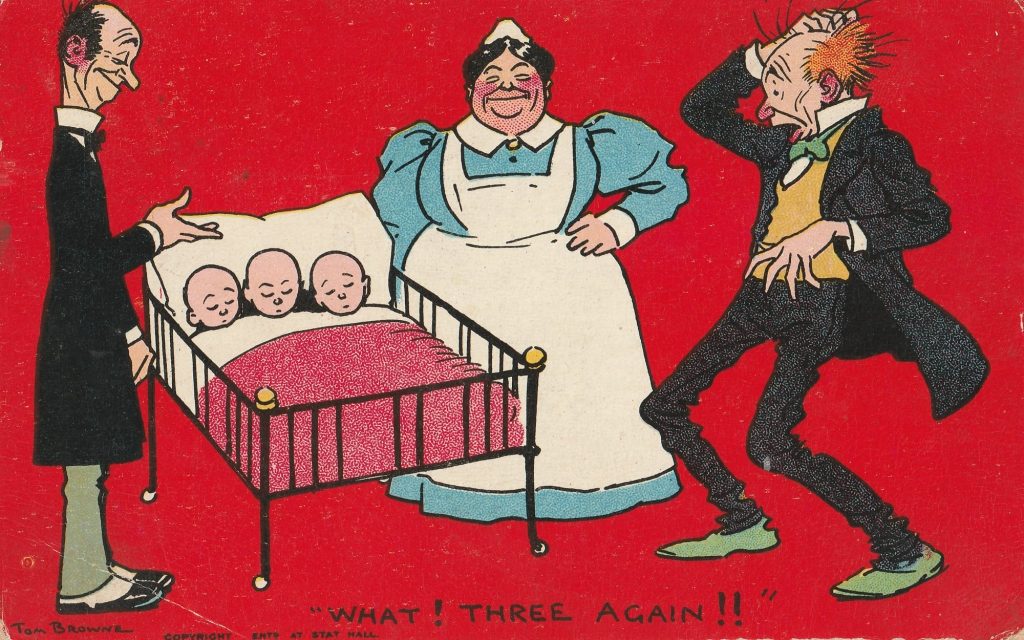Bob Teevan
There Were Six in a Bed
“There were six in a bed and the little one said, “Roll over, roll over.”

This postcard is a bit of fun and features a colorful comic card with an illustration by the great Tom Browne. There is an amusing musical link to the lyrics of a famous children’s counting song.
The card features a shocked father looking with dismay at a bed holding three babies. Standing at the side is a doctor and a nurse with looks on their faces that give away their pleasure and pride in what they (not the mother) have done.
The title of the card “What! Three Again!!” suggests that for the second time mother has given birth to triplets. Not only does the title infer this is the second set of triplets but the follicle challenged father had a full head of hair prior to the arrival of the first trio.
And, this poor man’s red nose is another sign of the stress he is under. We may wonder if he is dealing with the increased number of mouths-to-feed by having “one too many at the pub.”
The clever use of the color red makes the card stand out like a sore thumb. Or, perhaps a rosy nose.
What are the odds? With reasonable certainty that throughout history there would have been such a happy event, a newspaper search resulted in the discovery of articles confirming that this has happened at least three times in the last twenty years.
On these occasions the birth of a second set of triplets took place in Ohio (2007), Louisiana (2018), and Wisconsin (2020).
So, what are the odds of this happening? Again, newspaper articles suggest that the odds of a woman producing a set of triplets by natural conception is 9,000 to 1. The odds of a woman producing a second set of triplets by natural birth is suggested as 64 million to 1.
I thought 64 million to 1 to be quite high odds but I wanted to look at the numbers in some form of context and was surprised to discover that women are almost twice as likely to give birth to two sets of triplets than they are to win the top prize on the European National Lottery.
The postcard was mailed within Grantham in England on May 13, 1909 and is addressed to Mrs. F. Armstrong of Hough-on-the-Hill, Grantham. There is no reference to the illustration in the message, which is a request for Mrs. Armstrong to meet the sender at the Blue Lion in the marketplace on Saturday. L. B. and F. B. (Lucy Baker) and (Fred Baker) were the card’s signers.
Mrs. F. Armstrong was Jane Armstrong (aged 51) who in 1911 was the wife of Fred Armstrong, a 45-year-old agricultural laborer. They had four children. Three of whom were still home in that year.
Further research found that the eldest child was now Mrs. Lucy Baker. It may be assumed that the L. B. who sent the card was the addressee’s daughter Lucy with the second initial being that of two-year-old Fred Baker who was Lucy’s son and Mrs. Armstrong’s grandson.
The Blue Lion was a public house which stood in Grantham for many years. In fact, in Grantham many of the pubs and street names were prefixed with the word ‘Blue.’ Significant because they were all owned by a supporter of the Whig political party whose color was blue.
If Lucy’s invitation was accepted and Mrs. Armstrong met her daughter and grandson at the Blue Lion, we should hope that they had an enjoyable time.

We had twins, but our other child was only 1 1/2 years old. Almost like having triplets.
As I recall learning it, the ditty began “There were ten in a bed” and counted down until the “one in a bed” said “Good night!”
Yes, that’s the ‘ditty.’